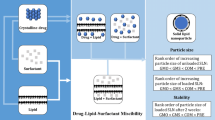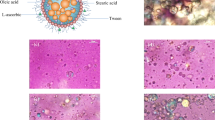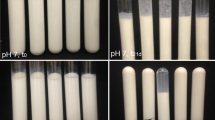Abstract
Hydrogenated soy phosphatidylcholine, tristearin and oleic acid were employed in preparing nanostructured lipid carriers (NLC). Surface modified NLCs (\(\hbox {NLC}_\mathrm{PEG})\) were formulated by adding polyethylene glycol 2000 (PEG 2000) in the dispersion medium along with Tween 60. Hot homogenization followed by ultrasonication technique was used as the preparative procedure. 0.01% (w/v, g/mL) PEG 2000 was found to be the saturation limit for the studied formulations. Pyrazinamide (PYZ) was incorporated in NLC; the base and drug-loaded formulations were characterized by combined dynamic light scattering (DLS), differential scanning calorimetry (DSC), transmission electron microscopy (TEM) and atomic force microscopy (AFM). \(\hbox {NLC}_\mathrm{PEG}\) was more stable than the conventional NLC formulations. Added PEG 2000 provided extra steric stability to \(\hbox {NLC}_\mathrm{PEG}\) systems by introducing an additional layer over their surface. The presence of the additional layer of PEG 2000 also offered a preventative barrier towards the expulsion of surface accumulated PYZ. Considerable improvement in entrapment efficiency (EE%), drug loading (DL%) and desirable sustained release profile could be achieved in NLC.
Graphical Abstract
Nanostructure lipid carrier (NLC) formulations were modified with PEG 2000. Pyrazinamide (PYZ) was incorporated into the NLC. Stability, entrapment efficiency and drug loading of the \(\hbox {NLC}_\mathrm{PEG}\) formulations were better than NLC. Sustained release of incorporated PYZ was recorded for \(\hbox {NLC}_\mathrm{PEG}\).








Similar content being viewed by others
References
Müller R H 2007 Lipid nanoparticles: recent advances Adv. Drug Deliv. Rev. 59 375
Müller R H, Radtke M and Wissing S A 2002 Solid lipid nanoparticles (SLN) and nanostructured lipid carriers (NLC) in cosmetic and dermatological preparations Adv. Drug Deliv. Rev. 54 S131
Müller R H, Radtke M and Wissing S A 2002 Nanostructured lipid matrices for improved microencapsulation of drugs Int. J. Pharm. 242 121
Müller R H, Rűhl D and Runge S A 1996 Biodegradation of solid lipid nanoparticles as a function of lipase incubation time Int. J. Pharm. 144 115
Ranpise N S, Korabu S S and Ghodake V N 2014 Second generation lipid nanoparticles (NLC) as an oral drug carrier for delivery of lercanidipine hydrochloride Colloid Surface B 116 81
Karmakar G, Nahak P, Guha P, Roy B, Chettri P, Sapkota M, Koirala S, Misono T, Torigoe K, Ghosh S and Panda A K 2016 Effects of Fatty Acids on the Interfacial and Solution Behavior of Mixed Lipidic Aggregates Called Solid Lipid Nanoparticles J. Oleo. Sci. 65 419
Nahak P, Karmakar G, Chettri P, Roy B, Guha P, Besra S E, Soren A, Bykov A G, Akentiev A V, Noskov B A and Panda A K 2016 Influence of Lipid Core Material on Physicochemical Characteristics of an Ursolic Acid-Loaded Nanostructured Lipid Carrier: An Attempt To Enhance Anticancer Activity Langmuir 32 9816
Nahak P, Karmakar G, Roy B, Guha P, Sapkota M, Koirala S, Chang C-H and Panda A K 2015 Physicochemical studies on local anaesthetic loaded second generation nanolipid carriers RSC Adv. 5 26061
Sapkota M, Karmakar G, Nahak P, Guha P, Roy B, Koirala S, Chettri P, Das K, Misono T, Torigoe K and Panda A K 2015 Effect of polymer charge on the formation and stability of anti-inflammatory drug loaded nanostructured lipid carriers: physicochemical approach RSC Adv. 5 65697
Li W, Das S, Ng K-y and Heng P W S 2011 Formulation, Biological and Pharmacokinetic Studies of Sucrose Ester-Stabilized Nanosuspensions of Oleanolic Acid Pharm. Res. 28 2020
Shah R M, Malherbe F, Eldridge D, Palombo E A and Harding I H 2014 Physicochemical characterization of solid lipid nanoparticles (SLNs) prepared by a novel microemulsion technique J. Colloid Interf. Sci. 428 286
Tamjidi F, Shahedi M, Varshosaz J and Nasirpour A 2013 Nanostructured lipid carriers (NLC): A potential delivery system for bioactive food molecules Innov. Food Sci. Emerg. Technol. 19 29
Yadav N, Khatak S and Singh Sara U V 2013 Solid lipid nanoparticles: a review Int. J. Appl. Pharm. 5 8
Man D K W, Casettari L, Cespi M, Bonacucina G, Palmieri G F, Sze S C W Leung G P H, Lam J K W and Kwok P C L 2015 Oleanolic Acid Loaded PEGylated PLA and PLGA Nanoparticles with Enhanced Cytotoxic Activity against Cancer Cells Mol. Pharm. 12 2112
Tang S, Gao D, Zhao T, Zhou J and Zhao X 2013 An evaluation of the anti-tumor efficac of oleanolic acid-loaded PEGylated liposomes Nanotechnology 24 1
Medina-O’Donnell M, Rivas F, Reyes-Zurita F J, Martinez A, Martin-Fonseca S, Garcia-Granados A, Ferrer-Martín R M, Lupianez J A and Parra A 2016 Semi-synthesis and antiproliferative evaluation of PEGylated pentacyclic triterpenes Eur. J. Med. Chem. 118 64
Das S and Chaudhury A 2011 Recent Advances in Lipid Nanoparticle Formulations with Solid Matrix for Oral Drug Delivery AAPS Pharm. Sci. Tech. 12 62
Mukherjee S, Ray S and Thakur R S 2009 Solid Lipid Nanoparticles: A Modern Formulation Approach in Drug Delivery System Ind. J. Pharm. Sci. 71 349
Pandey R and Khuller G K 2005 Solid lipid particle-based inhalable sustained drug delivery system against experimental tuberculosis Tuberculosis 85 227
Pandey R, Sharma S and Khuller G K 2005 Oral solid lipid nanoparticle-based antitubercular chemotherapy Tuberculosis 85 415
Wong H, Li Y, Bendayan R, Rauth M and Wu X 2007 Solid Lipid Nanoparticles for Anti-tumor Drug Delivery (Hoboken: Taylor and Francis)
Muhlen A Z, Muhlen E Z, Niehus H and Mehnert W 1996 Atomic Force Microscopy Studies of Solid Lipid Nanoparticles Pharm. Res. 13 1411
Shahgaldian P, Quattrocchi L, Gualbert J R M, Coleman A W and Goreloff P 2003 AFM imaging of calixarene based solid lipid nanoparticles in gel matrices Eur. J. Pharm. Biopharm. 55 107
Larsson K 1997 Cubosomes and hexosomes for drug delivery Proc. Int. Symp. Controlled Release Bioact. Mater. 24 198
Spicer P 2005 Cubosome processing industrial nanoparticle technology development Chem. Eng. Res. Des. 83 1283
Spicer P T 2003 Cubosome formation via dilution: Kinetic effects and consumer product implications ACS Symp. Ser. 861 346
Spicer P T 2005 Progress in liquid crystalline dispersions: cubosomes Curr. Opin. Colloid In. 10274
Dash S, Murthy P N, Nath L and Chowdhury P 2010 Kinetic modeling on drug release from controlled drug delivery systems Acta Pol. Pharm. 67 217
Zhang Y, Huo M, Zhou J, Zou A, Li W, Yao C and Xie S 2010 DDSolver: an add-in program for modeling and comparison of drug dissolution profiles AAPS J. 12263
Acknowledgements
Authors sincerely acknowledge Department of Science and Technology, Government of India, New Delhi for the financial support as research grant (SR/S1/PC-32/2011) for this work.
Author information
Authors and Affiliations
Corresponding author
Electronic supplementary material
Below is the link to the electronic supplementary material.
Rights and permissions
About this article
Cite this article
Karmakar, G., Nahak, P., Guha, P. et al. Role of PEG 2000 in the surface modification and physicochemical characteristics of pyrazinamide loaded nanostructured lipid carriers. J Chem Sci 130, 42 (2018). https://doi.org/10.1007/s12039-018-1448-x
Received:
Revised:
Accepted:
Published:
DOI: https://doi.org/10.1007/s12039-018-1448-x




